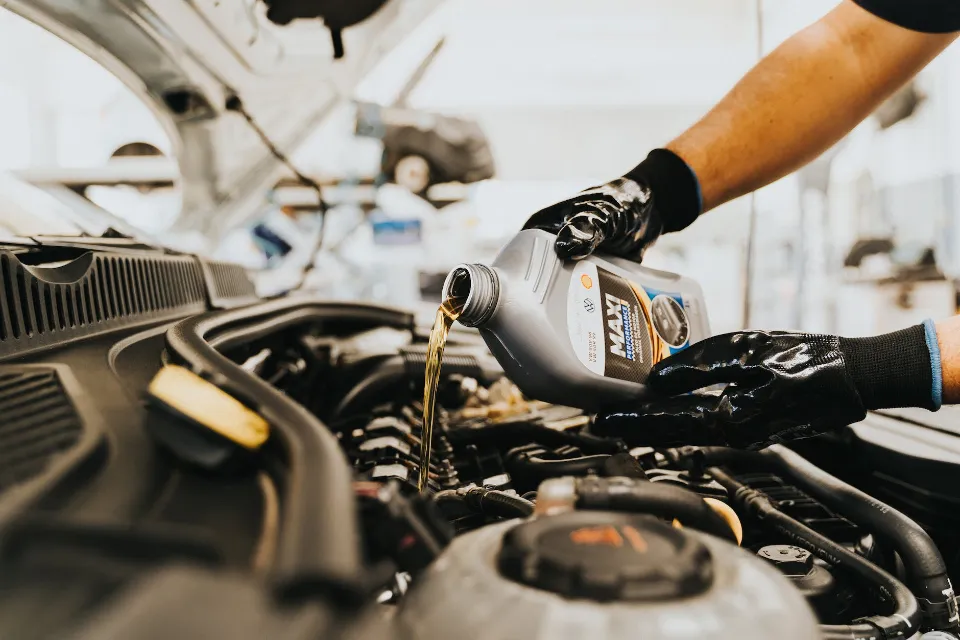Not certain “how much does an oil change cost”? Why oil change is essential? Discover the answer to these questions in this detailed and explanatory guide.
The price of an oil change varies depending on whether you do it yourself or hire a mechanic as well as what kind of oil your car needs. For a basic oil change at regional and national retailers, you can expect to pay at least $30 to $100.
Keep reading.
How Much is An Oil Change?
For an oil change service, there isn’t a set cost. If you take your car to a lubricant store or a car dealership, an oil change will typically cost you $30 to $100. Alternately, if you change your own oil, it typically costs $30 to $50.
The higher cost of an oil change typically results from higher labor costs (which vary depending on where you live), different filter quality, and any extra services (such as tire rotation) that are required.). For the most part, the price of oil for the same vehicle won’t vary depending on where you are.
What Factors Affect Oil Change Cost?
It’s fairly simple to perform a basic oil change: The oil and oil filter are both changed in the car. For an oil change, you should typically be prepared to spend between $20 and $70. However, the price will differ depending on a few elements, such as the kind of motor oil you select, the size of your car’s engine, and the location of the service.
Types of Motor Oil
When getting an oil change, there are four main types of motor oil to choose from.
- Conventional — It is usually less expensive than synthetics and is produced by refining crude oil.
- Full synthetic —Crude oil that has been refined, distilled, and purified is synthetic oil. It provides greater engine protection than regular oil because it has fewer impurities. Generally speaking, synthetic motor oil is more expensive than regular oil. According to a AAA study, full synthetic oil is especially beneficial for newer vehicles with turbocharged engines, as well as those that frequently drive in extreme weather or that tow heavy loads.
- Synthetic blend —This is a mixture of synthetic and traditional oils. Synthetic oil blends provide some of the extra engine protection that synthetic oil does, but they are less expensive than fully synthetic oil.
- High mileage —This oil was created specifically to support engines that have more than 75,000 miles on them. There are specialized additives in it that can lessen friction and corrosion. High-mileage oils can be conventional, synthetic, or synthetic blends.
Typically, the most economical course of action is to have a conventional motor oil change. For instance, an oil change with conventional motor oil begins at about $23 at Goodyear Auto Service.
The most expensive option is typically an oil change using full synthetic oil; Goodyear charges about $70 for this kind of oil change.
The Size of Your Car’s Engine
The size of your car’s engine also has an impact on how much an oil change costs.
Up to five quarts of oil are typically included with an oil change as part of the service fee. However, if you drive a vehicle with a bigger engine, such as a truck, your costs may start to increase because these vehicles may need more oil than the typical five quarts.

Conventional Vs. Synthetic
Four to five quarts of oil, an oil filter, and the shop’s labor cost are typically included in the price of an oil change. The type and quality of oil used will have the biggest impact on the final cost of the oil change. The trick is knowing the kind to get and how often to change your oil — which you can find in your owners manual, rather than following the outdated 3,000-mile rule.
Don’t try to save money by using conventional oil if your owner’s manual says that some newer cars need synthetic oil. (A lower-quality oil could void your warranty, and many shops won’t change your oil if you do.) Any money you save right now that you might lose later when you have to fix your engine.
You must use your judgment if your vehicle doesn’t require synthetic oil. Synthetic oil can be better for your car, resulting in “less engine wear over the life of the vehicle,” according to a 2017 report by At locations that have received AAA approval, the average cost difference between synthetic and conventional oil changes is about $32.
Lube Shops Vs. Dealerships
Additionally, you can have your oil changed at a dealership, which is a desirable option for owners of more specialized vehicles.
A dealer for the brand of your car is more likely to be familiar with the ins and outs of your car, including the type of oil it requires and any peculiarities with your model during the oil-change process, which can help avoid accidents in the future.
As a trade-off, you forfeit the convenience of visiting quick lube locations, which are typically simpler to locate than brand-specific dealerships. Additionally, the dealer may charge more because they use a particular brand of oil or have higher labor costs. Dealerships can, however, provide competitive pricing, so it may be worthwhile to inquire to determine whether visiting one makes sense for you.
Dealerships are also a good idea if you bought a warranty that covers maintenance (most warranties don’t; take note) or a service plan like Honda’s Service Pass, which covers some factory-required maintenance for two years or up to 24,000 miles.
Why the Cost of An Oil Change Varies?
It depends on how much work is needed, as with most auto maintenance and repairs. Some engines hold a lot more oil than others, and synthetic oil is more expensive than conventional oil. For instance, the tiny inline-four in a first-generation Mazda Miata will require about 3.4 quarts, whereas the 3.0-liter diesel in a W123 Mercedes-Benz 300D will need between seven and eight quarts. You’ll also need to budget for an oil filter and whatever the shop charges for labor on top of the price of the golden slippery stuff. You might anticipate paying a little more at a dealer for everything mentioned above, but we discovered that’s not always the case. Don’t be shocked if an oil change with filter replacement costs $75 since premium synthetic oil alone can cost between $20 and $30 for a five-quart bottle.
We visited four oil change locations in the area of our Ann Arbor, Michigan, office, one of which was a dealer, to confirm that price range. Using a fictitious 2018 Mazda MX-5 Miata that requires synthetic oil as our price tester, we discovered that the cost of an oil and filter change ranged from $71 at one location that offered a discount coupon to $84 at another location. The dealer quoted a price of $75.
DIY and Save
Of course, lay down some cardboard, unplug the drain, and get greasy if you have even a slight mechanical inclination, the necessary tools, and the time. Changing your own oil might be the least intimidating way to start learning how to work on a car, and in most cases shouldn’t take more than an hour. Also, you’ll spend less on labor! If you do it yourself, you can save a lot of money. For our hypothetical Miata, we found the right oil and filter on Amazon for a total of $33. In any case, you are now aware of the average cost of an oil change.

What Does An Oil Change Service Include?
An oil change service may include a variety of specific actions or services depending on who you hire and what’s involved.
At a bare minimum, anoil change involves:
- removing the oil pan drain plug from the bottom of your car.
- allowing oil to fully drain into a catch pan, another pan. The old oil is then disposed of in a way that is both legal and safe for the environment.
- swapping out the drain plug.
- Changing the oil filter.
- changing the oil and adding fresh oil. The majority of automobile engines require 5 quarts of oil.
As you can see, a standard oil change is a fairly simple procedure. Nevertheless, if you lack the necessary skills or preparation, it would be unwise for you to perform this important maintenance task.
How Often Should You Get An Oil Change?
Your engine’s oil cools the heat produced by the engine while lubricating moving parts.
You should typically change your oil every 3,000 to 7,500 miles, and some experts may even advise 15,000 if you’re using high-quality synthetic oil. This depends on the vehicle and the demands of your driving.
The best rule of thumb is to always look up the recommended intervals in your vehicle manual. Going 10,000–15,000 miles between oil changes can frequently result in significant engine damage. You should prepare to change the oil more frequently as your car ages. The number of oil changes you require annually can quickly increase depending on how many miles you drive in a given month.
You should think about your driving habits in addition to how many miles you log each week. Two distinct driving styles—normal and severe—may be mentioned in your manual. In most cases, normal circumstances entail driving and operating your vehicle in freely moving traffic. Severe conditions generally mean that you regularly do the following things:
- Your average driving distance is less than 10 miles.
- There is no extensive idling (like you’d do in stop-and-go traffic)
- You drive your vehicle on dusty or dirt roads
- You tow or carry a rooftop cargo bin on your vehicle
- You use your car for any kind of paid work (e.g. Uber or Lyft, taxis, deliveries, etc.)
- You experience cold winters and/or sweltering summers where you live and drive.
If you fall under the severe definition—for example, if you live in a major city and commute five days a week through stop-and-go traffic to work a few miles away—then you must adhere to the severe maintenance schedule. This implies that in order to keep your car in top operating condition, you will need to perform more frequent maintenance and have your oil changed more frequently.

How to Lower the Cost of An Oil Change?
Although getting your oil changed shouldn’t break the bank, there are a few wise tips and tricks you can use to cut the cost of that oil change.
If you only require an oil change and don’t require all the bells and whistles from a related car maintenance service, start by looking up coupons or discounts in your neighborhood. You can visit a quick lube shop that is offering a discount to get your oil changed on the cheap.
Second, consider taking a course to learn how to change your own oil. In the event that your car breaks down in the middle of nowhere, knowing how to change your own oil is a valuable life skill that will enable you to get back on the road.
Additionally, changing your own oil rather than taking your car to a shop or dealership can save you $50 or more once you learn how to do it.
Third, generally take good care of your car. The oil will need to be changed more frequently if you run your car constantly or don’t take care of it.
However, if you maintain your car properly, have routine maintenance performed on it, and adopt safe driving practices, your oil will only need to be changed occasionally, saving you money.
What Happens If You Don’t Get Your Oil Changed?
Your vehicle will eventually experience severe consequences if you don’t change the oil. The engine’s efficiency will decrease dramatically at first because it will initially run too hot. Without lubrication, your engine’s parts will eventually start to wear down and warp. Your engine’s lifespan will be shortened as time passes if you put off oil changes.
The entire engine will stop working if you skip too many oil changes in a row. You will now have to choose between buying a new car or having the engine replaced. You should try to avoid major repairs like new engines, which can cost thousands of dollars.

FAQs
Is It Cheaper to Do Your Own Oil Change?
Changing your own oil, then, is it less expensive? By doing this task yourself, you’ll save between $25 and $75 per oil change, depending on the type of oil and filter you use.
How Long Do Oil Changes Take?
Where you go and how busy the shop is will both have an impact on how long an oil change takes. An express lube shop can knock out an oil change in well under half an hour, but you may wait an hour or more at a busy dealership. If time is a concern, make an appointment and try to visit the shop at off hours, such as in the middle of the workday.
How Do I Get the Best Deal on An Oil Change?
While comparison shopping is helpful, it is best to keep an eye out for coupons and ongoing discounts. When getting other maintenance work done, it also helps to inquire about discounts. Visiting the shop to get new tires? Discover any discounts on oil changes. You can find coupons in your neighborhood newspaper and on the websites of the stores themselves.
Why is My Oil Change So Expensive?
There are valid reasons for this big span, mainly relating to your choice of oil. The most affordable choice is conventional oil, which is made from fossil fuels. The next level is a combination of natural and synthetic bases. Fully synthetic oil, which is most often used in luxury vehicles, is the most expensive oil.
Summary: How Much Does An Oil Change Cost?
The price of an oil change varies depending on whether you do it yourself or hire a mechanic as well as what kind of oil your car needs. For a basic oil change at regional and national retailers, you can expect to pay at least $30 to $100.
An oil change provides a mechanic with a good opportunity to identify any actual issues with your car as well as a chance to upsell you on services you don’t currently need.
So is it a scam when the oil change technician tells you that you need a transmission flush or a new air filter? Consulting the owner’s manual and knowing when your car last had the suggested maintenance are the best ways to determine if you’re being upsold.
If you have any questions, please leave a comment. KV Auto tries to give you the best car industry information. Thank you for reading.





